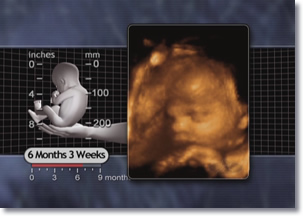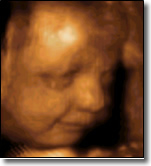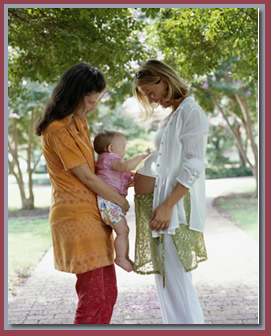Prenatal Form and Function – The Making of an Earth Suit
Unit 16: 6 to 7 Months (24 to 28 Weeks)
 Closer Look:
Closer Look:  Applying the Science:
Applying the Science: 
Copyright © 2006 EHD, Inc. All rights reserved.
24-week fetuses have impressive lung development as primitive gas exchange now becomes possible in the event of premature birth. Terminal sacs now appear which will eventually become alveoli.1 Alveoli become the site for the oxygen/carbon dioxide exchange and are essential for survival outside of the womb.
By 24 weeks the lung cells begin to produce a substance called surfactant,2 a substance absolutely necessary for successful gas exchange. The absence of this substance is often a limiting factor in the viability of premature newborns, as its absence precludes successful breathing. Neonatologists, or doctors specializing in the care of newborns, can introduce a drug form of surfactant to the lungs of premature babies, stretching viability, or the age at which survival outside the womb becomes possible, even farther back in pregnancy.3
At this point, the brain takes off on a growth spurt of its own. This brain growth consumes more than 50 percent of the energy used by the fetus and results in a brain weight increase between 400 and 500 percent.4

Copyright © 2006 EHD, Inc. All rights reserved.
By 25 weeks, the highly-developed eye now contains light-sensing cells called rods and cones.5 Rods allow the eye to detect very low levels of light, while cones detect color and produce sharp, highly focused images. There will be over 100 million rods and 7 million cones in each eye.6 By 26 weeks, the eye can produce tears.7 The pupils dilate and constrict in response to light as early as 27 weeks.8 Dilation and constriction regulate the amount of light reaching the retina throughout the human life cycle.9
The eye sees with two types of light-detecting cells. It uses rods to see in dusk and darkness, and cones to see in the light. Cones show us fine detail and color, but need relatively optimal conditions to see well. The six to seven million cones in each eye can be divided into "red," "green," and "blue" cones, according to what color the cone perceives. The estimated 100 million rods in each eye are perhaps 300 times more sensitive than cones. They enable us to see in low-light conditions, but create only a coarse, grey image. The rods adapt more slowly than the cones, and therefore optimum adaptation to darkness typically occurs after thirty minutes or more.


Whether using "cones" to see in the light, or "rods" to see in dusky conditions, our eyes are amazingly adaptable to our surroundings.
1 Arthur C. Guyton and John E. Hall, Textbook of Medical Physiology, 10th ed. (Philadelphia: W. B. Saunders, 2000), 582-584.


By this stage, parts of the nose are fully operational, with all components required for a functioning sense of smell in place. Infants born prematurely can detect odors as early as 26 weeks after fertilization.10


A sweet substance placed in the amniotic fluid increases the rate of fetal swallowing. In contrast, decreased fetal swallowing follows the introduction of a bitter substance.11 Altered facial expressions often follow.12 A pregnant woman’s dietary intake can reach the fetus rather quickly. For instance, amniotic fluid assumes the odor of garlic within 45 minutes of ingestion by pregnant women.13
Breathing motions begin to grow in amplitude as the fetus takes deeper “breaths.” The inspiratory part of the cycle now lengthens as each “breath” is drawn in over longer periods of time.14

The fetus has developed a relatively plump, less wrinkled appearance due to increased deposits of body fat underneath the skin.15 This subcutaneous fat provides a source of stored energy beneficial to survival.16 Fat deposits also help maintain body temperature after birth. Before birth, the placenta assumes this task, maintaining fetal temperature roughly between 100.7 and 102.5 degrees Fahrenheit17 - a few degrees higher than maternal body temperature.18
Through a series of step-like leg motions similar to walking, the fetus performs somersaults.19

Copyright © 2006 EHD, Inc. All rights reserved.

By 28 weeks, further ear development allows the fetus to distinguish between high and low pitched sounds.20
| 1 | DiFiore and Wilson, 1994. 222. |
| 2 | Moore et al., 2000. 154. |
| 3 | American Academy of Pediatrics, 1999. 684; Halliday, 1997. 233. |
| 4 | Dobbing and Sands, 1973. 764-765; Growth of the human brain, 1975. 6; Mancuso and Palla, 1996. 290. |
| 5 | Pringle, 1988. 181. |
| 6 | Noback et al., 1996. 266. |
| 7 | Isenberg et al., 1998. 773-774. |
| 8 | Robinson and Tizard, 1966. 52. |
| 9 | Noback et al., 1996. 263. |
| 10 | Lecanuet and Schaal, 1996. 3. |
| 11 | Lecanuet and Schaal, 1996. 3; Liley, 1986. 13; Reinis and Goldman, 1980. 227. |
| 12 | Liley, 1972. 102; Moore and Persaud, 1998. 234; Moore and Persaud, 2003. 219. |
| 13 | Mennella et al., 1995. 207. |
| 14 | Trudinger and Cook, 1990. 183-184. |
| 15 | England, 1983. 29; Pringle, 1988. 181. |
| 16 | Guyton and Hall, 2000. 786. |
| 17 | See Appendix A. |
| 18 | Liley, 1986. 12. |
| 19 | Liley, 1986. 11; Liley, 1972. 100. |
| 20 | Glover and Fisk, 1999. 882; Hepper and Shahidullah, 1994. F81. |











